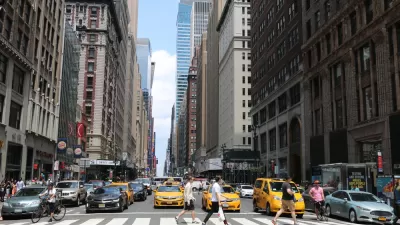The real estate intervened, and a proposed pied-à-terre tax became a mansion tax.

Ben Adler explains what happened to the proposed pied-à-terre tax that "would have generated $471 million a year, half of which would have come from just 280 homes worth more than $25 million," according to Wall Street Journal analysis. Analysis by New York City Comptroller Scott Stringer placed that number closer to $650 million a year.
According to Adler, that amount of funding was necessary to cover the gap between the potential revenue generating power of the city's proposed congestion pricing scheme, which could raise $15 billion over ten years toward an estimated $40 billion in required repairs to the MTA.
Instead of the proposed pied-à-terre tax, the New York Legislature and Governor Andrew Cuomo approved a tax that will have a broader impact but generate less funding. The 'mansion tax' will place a "surcharge on anyone buying a home in New York City for over $2 million and raising the real estate transfer tax on homes selling for more than $3 million." According to Adler, the Mansion tax will raise $365 million per year on average, an average subject to the whims of the real estate market in any given year.
Adler focuses much of the article on what was lost in the decision to change the pied-à-terre tax to a mansion tax; "the pied-à-terre tax would have killed three birds with one stone: raising revenue, revitalizing neighborhoods and reducing the obscene cost of housing."
For more on how the pied-à-terre tax became a mansion tax, see earlier news coverage by Vivian Wong.
FULL STORY: Pied-à-terre tax died for ridiculous reasons

Planetizen Federal Action Tracker
A weekly monitor of how Trump’s orders and actions are impacting planners and planning in America.

Chicago’s Ghost Rails
Just beneath the surface of the modern city lie the remnants of its expansive early 20th-century streetcar system.

San Antonio and Austin are Fusing Into one Massive Megaregion
The region spanning the two central Texas cities is growing fast, posing challenges for local infrastructure and water supplies.

Trump Distributing DOT Safety Funds at 1/10 Rate of Biden
Funds for Safe Streets and other transportation safety and equity programs are being held up by administrative reviews and conflicts with the Trump administration’s priorities.

German Cities Subsidize Taxis for Women Amid Wave of Violence
Free or low-cost taxi rides can help women navigate cities more safely, but critics say the programs don't address the root causes of violence against women.

New Atlanta Law Requires ‘Cool Roofs’
Painting roofs with reflective coatings can significantly reduce indoor temperatures and improve energy efficiency, sometimes at a lower cost than traditional roof treatments.
Urban Design for Planners 1: Software Tools
This six-course series explores essential urban design concepts using open source software and equips planners with the tools they need to participate fully in the urban design process.
Planning for Universal Design
Learn the tools for implementing Universal Design in planning regulations.
planning NEXT
Appalachian Highlands Housing Partners
Mpact (founded as Rail~Volution)
City of Camden Redevelopment Agency
City of Astoria
City of Portland
City of Laramie





























